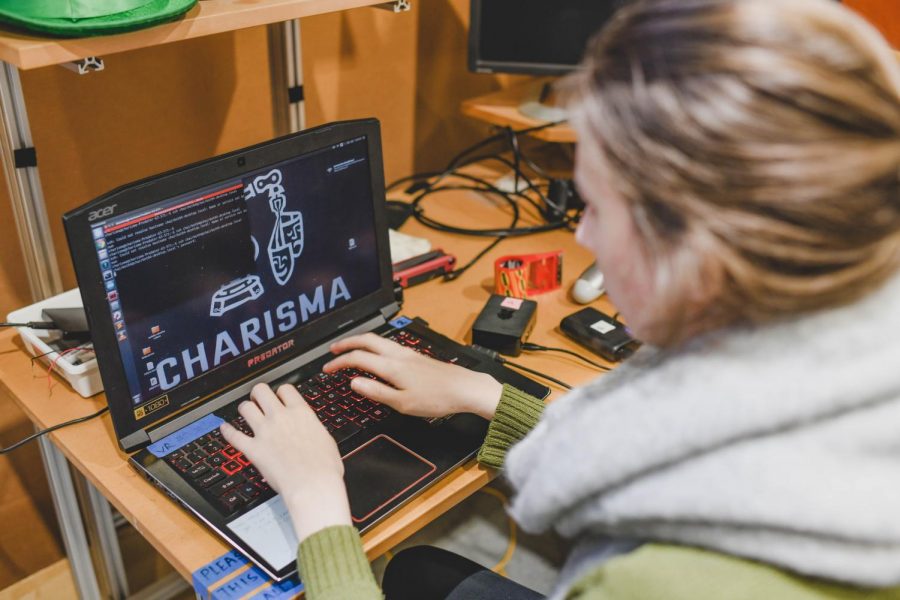CHARISMA lab aims to study human-robot interaction through performance
April 4, 2020
Oregon State University computer science professor Heather Knight is the founder and director of the CHARISMA robotics laboratory, which aims to study how humans and robots interact through collaborative performances.
As part of their research, the CHARISMA lab participates with robots in many live performance spaces around Corvallis. One well-known example is their involvement in the quarterly “Singu-hilarity” robot stand-up comedy nights at the Majestic Theatre. Other common spaces to find robots performing include the local farmers’ market and the Graf Hall office space.
Knight said that the CHARISMA lab also conducts “in the wild” studies, where robots are introduced into a free social space so researchers can monitor how humans respond. As an example, Knight mentioned their annual tradition of “Robot Halloween” in the Kelley Atrium, where robots perform and hand out candy to students.
Knight founded the CHARISMA lab when she began conducting research at OSU three academic years ago, with the name derived from an acronym for Collaborative Human and Robot Intelligence, Sociability, Machine learning, and Art.
Knight said that her research seeks to make more successful robots by designing robots that can interact with humans the way we interact with each other.
“I make robots that operate around people and that means that in order to make them not fail, we have to not offend people and not scare people, and be legible,” Knight said, “So we have to do the things people do with each other, but quantitatively, so that a machine can actually do that. It turns out that’s kind of like learning the grammar of your own language, it’s so obvious to you and I how we behave with each other that sometimes we have a hard time actually writing it down in a way a robot could do it.”
Outside of her research at OSU, Knight also founded the annual “Robot Film Festival” as a graduate student, with the goal of sharing storytelling about robots.
“Projects like the Robot Film Festival are really just an excuse to get creatives and technologists talking together, and thinking about the positive futures we can create with technology. Because I think films and storytelling is a great way to prototype the future,” Knight said.
Alexandra Bacula, a second year Ph.D student in robotics, is one of the researchers in the Knight laboratory.
Bacula said that she saw the goal of CHARISMA’s research as being “Bringing robots into the real world and having them interact with people in meaningful ways.”
To work toward this goal, Bacula said that performance allows the lab to simulate and study social situations.
“One way that our lab does that is using theatre methods and art methods to get robots into the world and test different social phenomena,” Bacula said. “It adds the social aspect to robots, so they’re not just purely functional, they also have an expressive aspect that needs to mesh well with people in order for them to be really successful and accepted in the real world.”
Janani Swaminathan, a second-year M.S. student in robotics, is a graduate research assistant in the Knight Laboratory, and one of the primary researchers interested in robot stand-up comedy.
Despite the data collection being performance-based and centered in sociology, Swaminathan said that the lab work is very intersectional.
“You have to build if you want to test the robot in terms of how humans perceive it, but we’re mainly focused on the human and robot interaction,” Swaminathan said. “We do something like, for example in the case of robot comedy we come up with some interesting factors, like ‘what is the audience most sensitive to, if the joke is about them, if the joke is about the robots themselves, or if the joke is about the people who made the robots’?”
Swaminathan listed post-performance surveys, statements from audience-members, and recording reactions like laughter or applause as being ways their lab has been able to collect data from social interaction.
According to Knight, Graf Hall houses the “largest concentration of human-robot researchers in the country”, with 13 core robotics faculty, 30 affiliated faculty, and over eighty graduate researchers. Knight encouraged all students interested in robotics to pursue involvement in undergraduate research.
























































































































